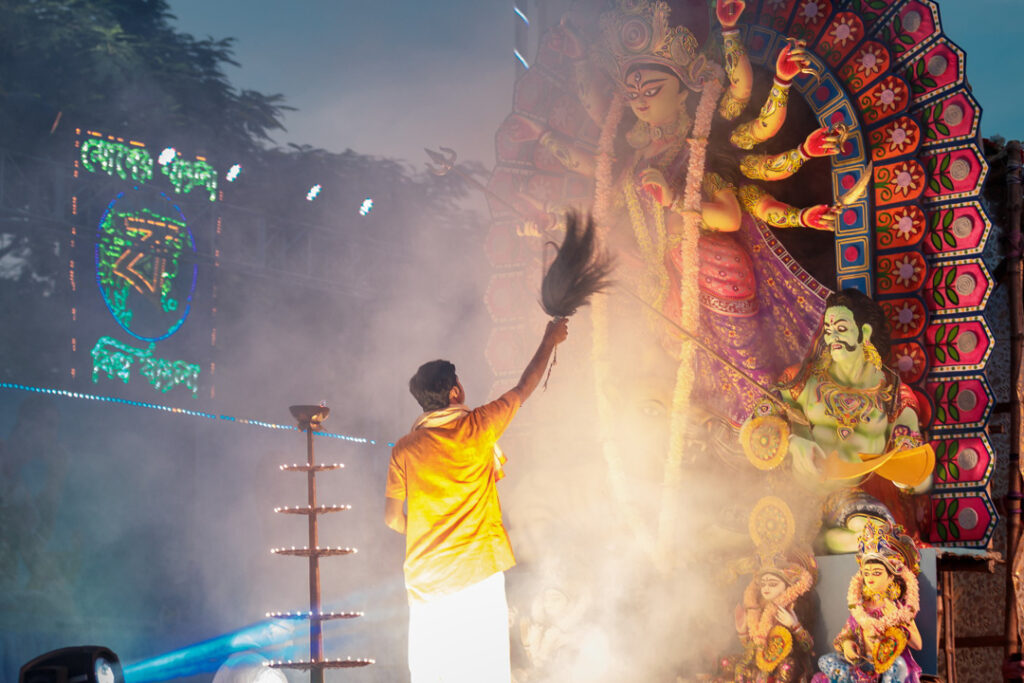Japneet Keith recounts the floral scents associated with the deities invoked in Durga Puja.
(A message to the reader in Hindi.)
(A message to the reader in English.)
Amidst the vibrant festivities of Durga Puja in Kolkata, my heart is brimming with both excitement and serenity. As I enter the elaborately adorned pandal, the fragrances of incense sticks and flowers instantly transport me to a realm of devotion and bliss. But amidst the sensory symphony, my mind keeps drifting to a cherished memory closer to home, the first lotus bloom in my house in Chandigarh.
As I pay my respects to the powerful goddess Durga, I can’t help but feel a connection with the divine through the lotus flower. It was a magical moment when I first laid eyes on the delicate pink petals of the lotus blooming in my own backyard. The flower’s pristine beauty instantly captivated me, and I couldn’t help but see it as a manifestation of Goddess Lakshmi’s blessings.
Just as the jasmine incense evokes the presence of Goddess Lakshmi in the pandal, the lotus bloom exudes an aura of purity and grace in my home. It is as if the goddess herself has chosen to grace my abode with her divine presence through this enchanting flower.
The scent of sandalwood, reminding me of Lord Shiva’s calming nature, resonates with my feelings for the lotus. The flower’s elegance and resilience in the midst of muddy waters mirror the serene composure of Lord Shiva, and I find solace in this connection.
The rose garlands in the pandal, symbolizing Lord Krishna’s love and charm, serve as a reminder of the affection I hold for the lotus flower. Like the mischievous deity, the lotus captivates my soul with its enchanting allure, becoming a cherished part of my spiritual journey.
As the fragrance of musk envelopes the pandal, symbolizing Lord Vishnu’s role as the preserver, I can’t help but marvel at the continuity of divine presence in both the grand festival and the modest lotus bloom. The flower’s blooming petals, seemingly representing the cyclical nature of life, are a testament to the eternal cosmic balance Vishnu embodies.
With the golden glow of camphor illuminating the pandal, dispelling darkness, I feel a sense of gratitude for the lotus that brightens my home. It feels like a divine light, guiding my spiritual path and filling my heart with joy and abundance.
As I offer my prayers in the pandal, I also send my heartfelt gratitude to the lotus bloom. Its presence in my life has brought a deeper sense of connection with the divine, reminding me of the blessings and abundance that Goddess Lakshmi bestows upon me.
Just like the incense sticks connect me to the divine realms during the puja, the lotus flower has become my conduit to seek blessings and find solace in the divine presence. Its enchanting fragrance, much like the essence of this grand festival, elevates my spiritual experience and leaves an indelible mark on my soul.
As I bid farewell to the joyous celebrations in Kolkata and return to my home in Chandigarh, I carry with me the profound love and passion I have for the lotus flower. It is no longer just a beautiful bloom; it is a symbol of divine blessings and a testament to my deep devotion to Goddess Lakshmi. Just as the fragrant festivity of Durga Puja touches my soul, the lotus bloom has become an eternal source of spiritual connection and an embodiment of the divine grace that surrounds me.
About Japneet Keith
 My heritage is Punjabi. I grew up in Chandigarh with my parents who believed in the teachings of Sikh religion. The foundation of the Sikh culture taught me to always believe in Sikh Congregational prayer (Ardas), the Sikh recites “Sikhan da mann nevan mat uchi.” It implies, may the Khalsa be humble in mind and exalted in understanding, or “May the passions in the hearts of the Sikhs remain calm and their reason flow clear, and may the reason always be guided by the light of God”. This resonates in me wherever I go. A woman follower of the Sikh doctrines is a sardarni. So I believe I am a sardarni in my nature and an ardent lover of my culture and roots. I was born and grew up in Chandigarh. For my further studies, I moved to Ahmedabad, Gujarat to pursue master’s in Design. I have been visiting Australia to work in this culture and it’s only now I can wholeheartedly say this is home as well. I teach pottery, absorb the tactile stories of our journeys, while I explore nature and form in clay and share as much as I can with the people I connect with. I am currently working towards an exchange programme between Indian & Australian communities, artists, and travellers. I work with the studio named RedMug studio pottery in India. Follow @redmugstudiopottery
My heritage is Punjabi. I grew up in Chandigarh with my parents who believed in the teachings of Sikh religion. The foundation of the Sikh culture taught me to always believe in Sikh Congregational prayer (Ardas), the Sikh recites “Sikhan da mann nevan mat uchi.” It implies, may the Khalsa be humble in mind and exalted in understanding, or “May the passions in the hearts of the Sikhs remain calm and their reason flow clear, and may the reason always be guided by the light of God”. This resonates in me wherever I go. A woman follower of the Sikh doctrines is a sardarni. So I believe I am a sardarni in my nature and an ardent lover of my culture and roots. I was born and grew up in Chandigarh. For my further studies, I moved to Ahmedabad, Gujarat to pursue master’s in Design. I have been visiting Australia to work in this culture and it’s only now I can wholeheartedly say this is home as well. I teach pottery, absorb the tactile stories of our journeys, while I explore nature and form in clay and share as much as I can with the people I connect with. I am currently working towards an exchange programme between Indian & Australian communities, artists, and travellers. I work with the studio named RedMug studio pottery in India. Follow @redmugstudiopottery


